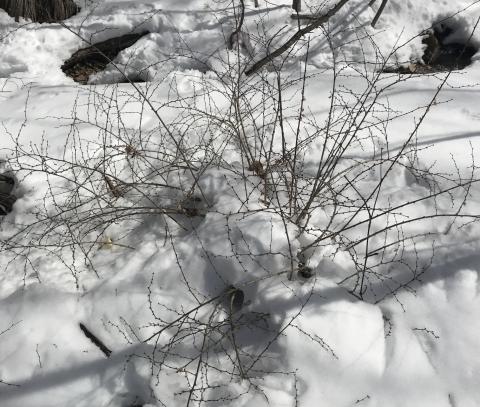Invasive in the Spotlight: Japanese Barberry

Japanese Barberry (Berberis thunbergii) is deciduous, multi branched shrub that is native to Japan, and is often used as an ornamental shrub in the landscape. Unfortunately, it has escaped cultivation and is frequently found growing in dense masses in forest understories, open fields, or roadsides. Japanese barberry generally grows to be 2 to 5 feet tall and has stems that are thickly covered with small opposite leaves and thorns. In the winter and early spring you can identify Japanese barberry by its arching, spiny branches and red glossy fruits. Its roots and shoots also have distinctive yellow inner bark. Japanese barberry is one of the earliest plants to leaf out in the spring, which can also aid in its identification.

Japanese barberry is a prolific seed producer. Its fruit is consumed by many different wildlife species, who in turn disperse the seeds in their droppings. Japanese barberry if of concern because of its tendency outcompete native plants. In addition, it is also associated with an increase of Lyme disease in areas where it has formed dense thickets. Its dense growth habit creates a humid environment that increases tick survival and populations. White footed mice serve as the larval host of Lyme carrying ticks, and they also tend to prefer the shelter of barberry. The incidence of Lyme disease is much higher in areas with heavy barberry infestations, than those where the plant is absent or has been controlled.
Control
Hand removal is the best option for eliminating small, isolated plants. Larger plants can be removed with a garden spade, hoe, or weed wrench. Take care to wear thick gloves to protect your hands from the sharp thorns. Try to remove as much of the root system as possible because Japanese barberry can easily re-sprout from the remaining roots. Large populations can be effectively controlled using recommended herbicides. Integrated pest management is the best choice.
Alternative Plants for Your Landscape
Japanese barberry is a prohibited invasive plant species in New Hampshire. Gardeners who have this plant in their landscape should consider eliminating it and replacing it with a non-invasive alternative such as:
Weigela (Weigela florida)
Slender deutzia (Deutzia gracilis)
Common ninebark (Physocarpus opulifolius)
Shrub roses (Rosa species and hybrids)
UNH Cooperative Extension Master Gardener volunteers share information about home, yard, and garden topics with the people of New Hampshire. Got questions? Master Gardeners provide practical help finding answers to your questions through the Ask UNH Extension Infoline. Call toll free at 1-877-398-4769, Monday to Friday, 9 a.m. to 2 p.m., or e-mail us at answers@unh.edu.
Related Resource(s)

